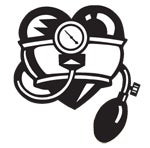DASH Diet
Understanding The DASH Diet
What’s special about the DASH Diet?
Research has shown that the Dietary Approaches to Stop Hypertension (DASH) Diet is a very effective eating plan to help lower blood pressure.
The DASH approach encourages a high intake of fruits and vegetables (8-10 servings each day); a regular intake of low-fat and non-fat dairy foods (2-3 servings each day); and small servings of meat, poultry and fish (up to 2 servings each day).
Boost Your Nutrition!
A diet rich in potassium, calcium and magnesium can play an important role in achieving healthy blood pressure. Eat the following foods regularly to increase the nutritional value of your diet:
- Fresh Vegetables & Fruits: choose fresh, frozen or no-salt added canned vegetables whenever possible. Great choices include: broccoli, cabbage, cauliflower, green leafy vegetables, oranges, bananas, melons, apples, pears and peaches.
- Low-fat Dairy Foods: choose non-fat or 1% milk, yogurt, fat-reduced cheese. If you have trouble digesting dairy foods, try taking lactase enzyme pills or drops with the dairy foods. Many lactose-free products are available. Look for calcium and Vitamin D fortified soy milk or lactose-free milk (such as Lactaid).
- Whole Grains: choose whole grain breads, cereals, wheat germ, bran and oats to get added nutrients, such as minerals and fiber.
Getting Started
Make gradual changes
- Start with your vegetable intake… add to your typical daily meals an extra serving of vegetables at lunch and another serving at dinner.
- If you don’t eat fruit now or have only juice at breakfast, add a serving to your meals or have it as a snack.
- Gradually increase your use of fat-free and low-fat dairy foods to two to three servings a day. For example, drink milk with lunch or dinner instead of soda, sugar-sweetened tea or alcohol. Choose lowfat (1%) or fat-free (skim) dairy products to reduce your intake of saturated fat, total fat, cholesterol and calories containing ingredients. Most restaurants are willing to accommodate requests.
- Know your terms: words like “pickled,” “cured,” “soy sauce” and “ broth” indicate a higher sodium content.
- Move the salt shaker away. Choose pepper or salt-free seasonings instead.
- Limit condiments such as mustard, catsup, pickles and sauces with salt-containing ingredients.
- Choose fruits or vegetables instead of salty snack foods.
What about desserts and snacks?
- Fruits and other low-fat foods offer great taste and variety. Use fruits canned in their own juice. Fresh fruits require little or no preparation. Dried fruits are a good choice to carry with you or to have in the car.
- Try these snack ideas: unsalted pretzels or nuts mixed with raisins; graham crackers; low fat or fat-free frozen yogurt; and popcorn with no-salt or butter added. Best option: a variety of raw vegetables.

What’s a Serving?
Examples of 1 Serving
* Serving sizes are based on DASH Diet, but modified to reflect diabetic “exchanges.”

1/2 cup bran cereal
1 small banana
1 cup fat-free milk
OR
1/2 cup regular oatmeal,
with 1 tsp cinnamon
and sugar substitute
1/2 English muffin
2 Tbsp raisins
1 cup fat-free milk
1 Tbsp fat-free cream cheese
3 oz turkey breast
2 slices wheat bread
8 oz skim milk
1 lg leaf romaine lettuce
2 slices tomato
2 tsp low fat mayonnaise
1 Tbsp Dijon mustard
1 cup carrot sticks
1 medium orange
OR
1/2 cup tuna salad
1 lg leaf romaine lettuce
2 slices wheat bread
1/2 cup 1% or 2% cottage cheese
1 cup canned pineapple (unsweetened)
4 small celery sticks
2 Tbsp fat-free ranch dressing
3 oz. Turkey meatloaf
1 Tbsp catsup
1 small baked potato
1 tsp soft margarine
1 Tbsp low fat sour cream
1 scallion stalk, chopped
1 cup collard greens, cooked from frozen
1 medium peach
1 cup fat free milk
OR
3 oz white fish
1 tsp lemon juice
2/3 cup brown rice, long grain
1/2 cup spinach, cooked
1 small corn bread muffin
1 tsp soft margarine
(2-3 servings/day)
1 cup non-fat fruit yogurt (no sugar added)
2 - 4 Tbsp raisins or other dried fruit
2 - 3 graham cracker squares with 1 Tbsp peanut butter
1/3 cup almonds or other unsalted nuts